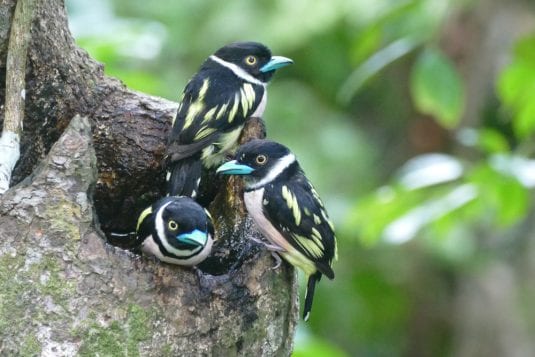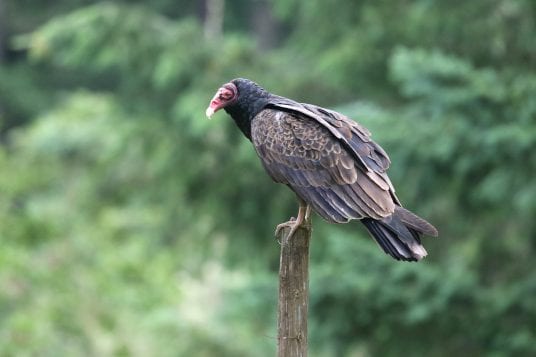Author and SBU master’s student Noah Strycker chases birds, travels the world
By Daniel Dunaief
Noah Strycker once made a bet with a cruise ship full of passengers: if any of them spotted him without binoculars at any point during a 14-day trip, he would buy them all drinks. Even with that incentive, no one won a free drink, in large part because Strycker’s passion for birds means his binoculars are never out of arm’s reach.
A master’s candidate in Heather Lynch’s lab at Stony Brook University, Strycker, who has turned his world travels in search of his feathered friends into books, is working through the second year on Lynch’s specialty: penguins.
As a part of the team, Strycker is contributing to a population analysis of chinstrap penguins. Last year, he ventured to Antarctica with a field team for several months to count colonies of these six-to-ten pound birds.
The “piece de resistance” of that journey was a trip to Elephant Island, which is where, over 100 years earlier, Ernest Shackleton and his crew were marooned for several months before their rescue.
During Strycker’s journey to the famous but uninhabited island, the team counted the number of chinstrap and compared the population to the last known count, which occurred 50 years ago.
They determined that the chinstrap has had a significant decline, in some cases losing more than half its population in some areas. After a survey of Elephant Island and Low Island, the research team suggested that the decline in the chinstrap’s main source of food, krill, likely caused this reduction.
As for this year, Strycker had planned to travel back to Antarctica until the pandemic caused the cancellation of the trip. He is conducting a literature search to find previous chinstrap penguin counts. In the final part of his master’s program, he will help provide an updated assessment for the International Union for the Conservation of Nature.
While the IUCN provides information on threatened or endangered species, Strycker recognizes that the chinstrap won’t likely be on that list. “There are many millions of them,” he explained in a recent interview. “[But] they are declining. We are trying to give the IUCN updated information.”
Lynch’s lab will provide information for IUCN’s green list, which is for species that aren’t endangered. Species on this list might benefit from additional information that could help shape a future conservation strategy.
Strycker, who traveled to 41 countries in 2015 to count as many birds as possible in a year, appreciated and enjoyed his interaction with penguins. These flightless birds have no fear of humans so they waddled up to him and untied his shoelaces. They also fell asleep next to his boot and preened the side of his black wind pants.
Strycker landed in the world of penguins when he was working as a naturalist guide on a cruise ship and met Lynch, whose team was on the same boat.
Lynch was delighted with the chance to add Strycker to her team. “One of the most difficult things about our work is that there is such a steep learning curve for doing Antarctic field research,” Lynch explained in an email. “To grab someone like [Strycker] with so much Antarctic experience under his belt was just fantastic.”
Lynch appreciates how Strycker led the chinstrap survey work, not just in collecting the data but also in analyzing and writing it up. Strycker is “a terrific writer (and very fast, too) and his finesse with writing helped us get our research out for review faster than would normally be possible,” she said.
After seeing and hearing birds around the world, Strycker has an unusual favorite — the turkey vulture. When he was in high school in Eugene, Oregon, Strycker watched a nature documentary with David Attenborough in which the host put rotting meat out in a forest. In no time at all, turkey vultures discovered the feast. “That is the coolest thing I’ve seen,” Strycker recalls thinking.
Months later, he discovered a road kill deer while he was driving. He put the dead animal in the trunk of his ’88 Volvo Sedan and dumped it in his front yard, waiting to see if he could duplicate Attenborough’s feast. Fairly soon, 25 turkey vultures arrived and were sitting on the roof of his house. The neighbors didn’t complain because Strycker grew up on a dead end, 20 acres from the nearest house.
Fortunately for him, his parents didn’t seem too upset, either. “When they realized that their only child had become addicted to birds at a young age, they rolled their eyes and said that there’s much worse things that he could become addicted to,” Strycker recalled.
As for Long Island, Strycker said the area is currently in fall migration season. All the birds that nested in Canada are passing through New York on their way to spend the winter in warmer climates.
The migration patterns typically start with shorebirds in August, transition to warblers in September and to waterfowl, such as ducks and geese, which appear in October and November.
“This fall has also been exciting because several species of northern songbirds have ‘irrupted’ south, so we’re seeing unusually high numbers of them on Long Island,” said Strycker. This month, red-breasted nuthatches, purple finches, and pine siskins have appeared in large numbers, which doesn’t happen every year.
At this time of year, birds sometimes get lost outside their usual range. Last week, a painted redstart, which should be in Arizona, arrived in Floyd Bennett Field in Brooklyn.
“I was out there at dawn the next morning, along with half the birder population of New York, but unfortunately it had already moved on,” said Strycker.
People interested in tracking bird migration by radar can use the website birdcast.info, which can predict bird migration like the weather using radar data. Strycker advises interested birders to type “Stony Brook” into their local Bird Migration Alert tool.
Once he earns his degree, Strycker plans to build on and share his experiences.
He would like to write books, give presentations and “generally inspire the world about birds.”











